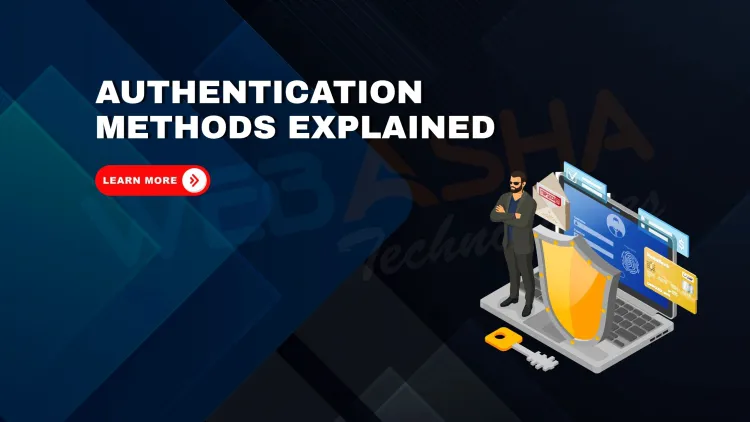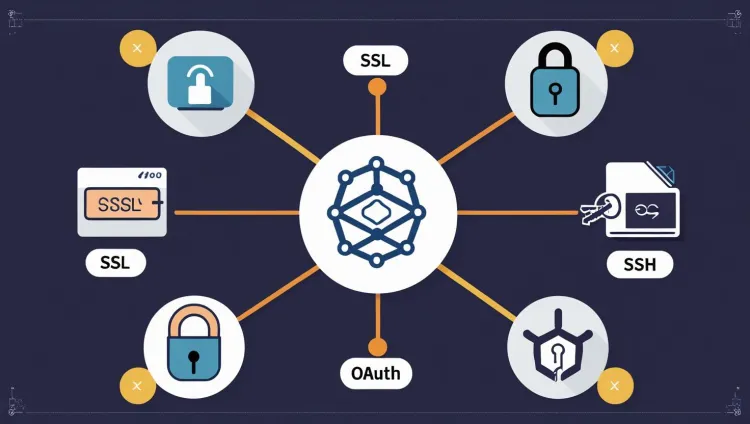What are the most commonly used authentication mechanisms in cybersecurity and how do they work?
Authentication mechanisms like Credentials, SSL Certificates, OAuth Tokens, and SSH Keys are critical for securing communication and access in modern networks. Each mechanism uses a unique approach—password-based login, certificate validation, token exchange, or key-pair verification—to ensure that only legitimate users and systems can connect. In this blog, we break down each method with clear explanations and a visual guide.

Table of Contents
- What Are the Most Common Authentication Mechanisms?
- Credentials Authentication
- SSL Certificates Authentication
- OAuth Token Authentication
- Summary Table: Quick Comparison
- Why It Matters
- Frequently Asked Questions (FAQs)
Authentication is the foundation of secure digital access. Whether logging into an email account, accessing cloud resources, or making an API call, authentication ensures that users and systems are who they claim to be. In this blog, we’ll break down the four most used authentication mechanisms—Credentials, SSL Certificates, OAuth Tokens, and SSH Keys—with visual insights and step-by-step explanations from the Ethical Hackers Academy.
What Are the Most Common Authentication Mechanisms?

The four most widely adopted authentication types are:
| Mechanism | Used For | Security Type | Common Use Case |
|---|---|---|---|
| Credentials | Basic website and app logins | Password-based | User login via username/password |
| SSL Certificates | Browser-server secure connections | Certificate-based | HTTPS for websites |
| OAuth Tokens | API and 3rd-party service integrations | Token-based | Logging in with Google, Facebook, etc. |
| SSH Keys | Server and network access | Public-key cryptography | DevOps remote server access |
Credentials Authentication
How It Works:
-
The client sends a username and password over a secure HTTPS connection.
-
The server decrypts the connection using its SSL certificate and private key.
-
It performs a username lookup and verifies the hashed password in the user database.
-
The result of the verification is sent back as an authentication status.
Encryption Note: Credentials are encrypted in transit using SSL to prevent interception.
SSL Certificates Authentication
How It Works:
-
The client accesses a secure website via
https://. -
The server sends an SSL certificate to the client.
-
The client checks:
-
Certificate expiry
-
Certificate Authority (CA) trust
-
Domain name match
-
-
If valid, the client proceeds with a secure encrypted connection using a random key, which is encrypted by the server’s SSL certificate.
✅ SSL ensures both encryption and server identity validation.
OAuth Token Authentication
How It Works:
-
The client initiates an access token request using a Client ID and Client Secret.
-
The Authorization Server validates the client’s identity and issues an access token.
-
The token is included in each API request as a
Bearertoken. -
The API server:
-
Extracts the token
-
Validates the token
-
Returns the requested data or an error code
-
Common Response Codes:
-
200 OK: Token is valid -
400 Bad Request: Token malformed or missing -
401 Unauthorized: Token invalid or expired
Used by services like Google, GitHub, and Microsoft APIs.SSH Key Authentication
How It Works:
-
The client uses a host key pair (public/private).
-
The public key is placed on the server beforehand.
-
During login:
-
The server sends a challenge encrypted with the public key.
-
The client responds using the private key.
-
-
If the response is valid, authentication succeeds.
Components:
| Key Type | Description |
|---|---|
| User Key | User’s personal SSH keypair |
| Host Key | Server’s SSH keypair |
| Client Host Key | Machine’s SSH identity |
SSH keys provide strong, passwordless authentication ideal for sysadmins and DevOps.
Summary Table: Quick Comparison
| Authentication | Security Type | Best Used For | Key Components |
|---|---|---|---|
| Credentials | Password-based | User logins | Username, password, SSL |
| SSL Certificates | Public Key Infrastructure | Website-server security | Certificate, CA, domain match |
| OAuth Tokens | Token-based | API and 3rd-party app access | Access tokens, client ID/secret |
| SSH Keys | Public-key cryptography | Remote server access | Public/private keys |
Why It Matters
Each authentication mechanism serves a unique purpose. While credentials are simple and widely used, they're prone to phishing. SSL protects data in transit, OAuth secures delegated access, and SSH offers robust, passwordless login to critical systems. Understanding these mechanisms helps developers, sysadmins, and security professionals secure digital systems more effectively.
FAQs
What are the main types of authentication mechanisms?
The main types include Credentials (username/password), SSL Certificates, OAuth Tokens, and SSH Keys.
How does password-based authentication work?
It verifies a user’s identity using a username and a password, often encrypted over SSL during transmission.
What is the role of SSL Certificates in authentication?
SSL certificates establish trust between the client and server by validating the server’s identity through a trusted Certificate Authority.
What is OAuth token authentication?
OAuth uses temporary tokens issued by an authorization server to allow access to APIs without revealing passwords.
How do SSH keys secure authentication?
SSH uses public-private key pairs where a client proves identity by using a private key matched to a known public key on the server.
Is SSL secure for authentication?
Yes, when properly configured, SSL ensures encrypted communication and authentication through digital certificates.
What is the difference between authentication and authorization?
Authentication verifies identity; authorization determines access rights.
Can OAuth be used in mobile apps?
Yes, OAuth is widely used in mobile and web apps for secure API access.
Why is two-factor authentication important?
It adds an extra layer of security by requiring a second form of identification.
What are common issues with password-based login?
Weak passwords, reuse across sites, and phishing attacks are common issues.
How can SSL certificates be compromised?
Through expired certs, misconfigured servers, or certificate spoofing.
What is a bearer token in OAuth?
It is a token that grants access to resources without re-authenticating the user.
Are SSH keys safer than passwords?
Yes, SSH keys are much harder to brute-force than traditional passwords.
What is a certificate authority (CA)?
A CA is a trusted entity that issues digital certificates for verifying identities.
What happens if an OAuth token expires?
The client must request a new token using a refresh token, if available.
How do HTTPS and SSL relate?
HTTPS uses SSL/TLS to encrypt and authenticate data transferred between browsers and servers.
What is a client ID in OAuth?
A unique identifier for an application requesting authorization.
Can SSH keys be shared?
No, private SSH keys should never be shared; only public keys can be distributed.
How to generate an SSH key pair?
Using tools like ssh-keygen to create a secure public-private key pair.
What’s the difference between public and private keys?
Public keys are shared; private keys are kept secret and used for authentication or decryption.
Can SSL work without a certificate?
No, a valid SSL certificate is required for the protocol to function securely.
How to store OAuth tokens securely?
Use secure storage mechanisms like encrypted databases or key vaults.
Do SSH keys expire?
No, but they should be rotated periodically for better security hygiene.
What is mutual TLS authentication?
Both the client and server present and verify certificates for two-way SSL.
How to revoke an SSL certificate?
Through the CA’s revocation mechanisms like CRL or OCSP.
Are OAuth tokens encrypted?
They can be signed and optionally encrypted depending on the implementation.
How is token validation done?
By checking the token’s signature, expiry, and associated permissions.
Can multiple users use the same SSH key?
It's not recommended due to auditing and accountability concerns.
What is token expiration in OAuth?
It’s the time limit for how long a token remains valid before needing renewal.
How does username/password authentication fail?
Due to brute-force attacks, leaked credentials, or poor password policies.
Why use authentication mechanisms in layers?
Layered authentication provides defense in depth, enhancing security posture.














![Top 10 Ethical Hackers in the World [2025]](https://www.webasha.com/blog/uploads/images/202408/image_100x75_66c2f983c207b.webp)








